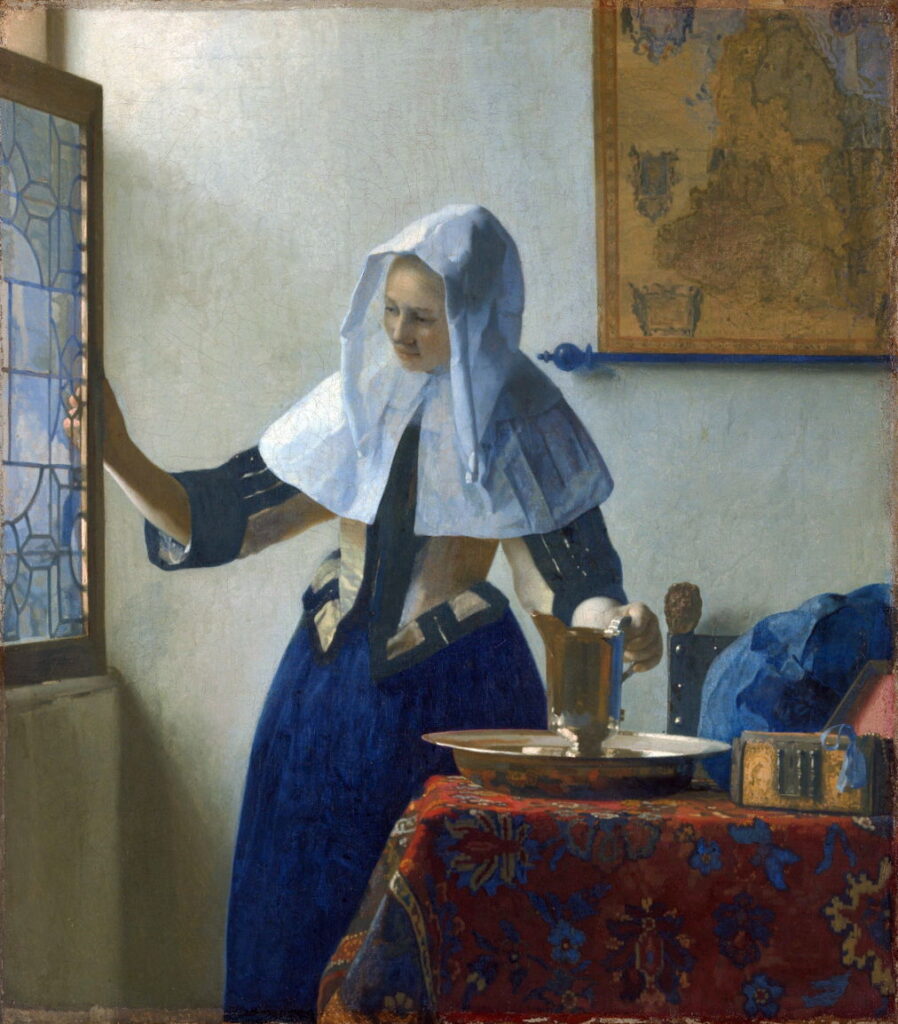Interiors by design: The Dutch Golden Age

Painting in the Dutch Golden Age underwent remarkable evolution. In the fifty years between the 1620s and the French invasion of the Dutch Republic in 1672, established genres grew novel sub-genres, with artists specialising in each. These included ‘genre’ scenes of everyday life, with artists devoted to painting taverns, women working, festivities, markets, or domestic interiors. The latter appear to have been among the first such depictions in modern art.
During the 1650s, interiors started to become distinct from other scenes of everyday life, as the significance of their figures diminished, although few if any dispensed with them altogether.
Gerard ter Borch (1617–1681) specialised in domestic interiors, some containing open-ended narratives to encourage the viewer to speculate on their resolution. Two centuries later, those were to be become popular again, particularly in Britain, where they were known as problem pictures and featured in the press.
Gerard ter Borch (1617–1681), The Messenger (Unwelcome News) (1653), oil on panel, 66.7 x 59.5 cm, Koninklijk Kabinet van Schilderijen Mauritshuis, The Hague, The Netherlands. Wikimedia Commons.
Ter Borch’s The Messenger, usually know as Unwelcome News, from 1653, develops his favourite theme of the arrival of a message. The young man at the left is still booted and spurred from riding to deliver a message to this couple. Slung over his shoulder is a trumpet, to announce his arrival and assert his importance. The recipient wears a shiny breastplate and riding boots, and is taken aback at the news the messenger brings. His wife leans on her husband’s thigh, her face serious.
The scene is the front room of a house in the Golden Age. Behind them is a traditional bed typical of living areas at the time, with some of their possessions resting on a table between the couple and their bed. Hanging up on a bedpost is the husband’s sword, and behind them are a gun and powder horn. Is this letter news of his recall to military service, perhaps? Will he soon have to ride away from his wife, leaving her alone to bring up their family?
Although the three figures take the limelight, ter Borch picks out the mundane details of the room behind them instead of letting them fade into darkness.
Gerard ter Borch (1617–1681), Three Figures Conversing in an Interior (Paternal Admonition) (c 1653-55), oil on canvas, 71 x 73 cm, Rijksmuseum Amsterdam, Amsterdam, The Netherlands. Wikimedia Commons.
Three Figures Conversing in an Interior is another of ter Borch’s narrative genre works, and more popularly known as Paternal Admonition (c 1653-55). Standing with her back to us, wearing a plush going-out dress, is the daughter. To her left is a table, on which there’s a small reading stand with books, almost certainly including a Bible.
Her parents are young, and they too are fashionably dressed. Her mother appears to be drinking from a glass, but her father is at the very least cautioning his daughter, if not giving her a thorough dressing-down. He wears a sword at his side. Behind them is a large bed, and to the right the family dog looks on from the darkness.
Gerard ter Borch (1617–1681), Woman Writing a Letter (c 1655), oil on panel, 39 x 29.5 cm, Koninklijk Kabinet van Schilderijen Mauritshuis, The Hague, The Netherlands. Wikimedia Commons.
Ter Borch’s half-sister Gesina appears to have been his model for Woman Writing a Letter (c 1655), which makes obvious his connection with Vermeer. Move this woman to a desk lit through windows at the left, light her surroundings, and you have a painting similar to Vermeer’s interiors. This shows a heavy decorated table cover pushed back to make room for the quill, ink-pot, and letter. Behind the woman is her bed, surrounded by heavy drapery, and at the lower right is the brilliant red flash of the seat.
Gerard ter Borch (1617–1681), The Letter (c 1660-62), oil on canvas, 79 x 68 cm, The Royal Collection, London. Wikimedia Commons.
The Letter from about 1660-62 returns to ter Borch’s favourite theme of the reading and writing of letters. Two young women are working together, apparently replying to the letter being read by the woman on the right. A boy, perhaps their younger brother, has just brought in a tray bearing an ornate pitcher of drink. In front, a small dog is curled up asleep on a stool. Above them is an unlit chandelier suspended from a hanging ceiling.
Gabriël Metsu (1629–1667), Washerwoman (c 1650), oil on panel, 23.9 × 21 cm, Muzeum Narodowe w Warszawie, Warsaw, Poland. Wikimedia Commons.
Other specialists in genre painting like Gabriël Metsu also ventured towards interiors. His Washerwoman from about 1650 looks authentic and almost socially realist: the young woman is a servant, dressed in her working clothes, in the dark and dingy lower levels of the house. She looks tired, her eyes staring blankly at the viewer. She’s surrounded by the gear she uses, including a rope and pitcher to the right, and an earthenware bowl on display below it. The mantlepiece in the background features a blue and white plate.
Pieter de Hooch (1629–after 1684), A Woman Drinking with Two Men (c 1658), oil on canvas, 73.7 x 64.6 cm, National Gallery, London. Wikimedia Commons.
It’s easy to mistake Pieter de Hooch’s A Woman Drinking with Two Men from about 1658 for a Vermeer, and like the latter he decorates the far wall with a contemporary map. The Eighty Years’ War had not long ended, and the Dutch Republic was flourishing. Discarded objects are scattered on its black-and-white tiled floor. There’s a large and empty fireplace, and above it hangs a religious painting.
It was Jan Vermeer whose few surviving works explored interiors the most.
Johannes Vermeer (1632–1675), The Milkmaid (c 1660), oil on canvas, 45.5 x 41 cm, The Rijksmuseum Amsterdam, Amsterdam, The Netherlands. Wikimedia Commons.
In his Milkmaid from about 1660, a woman servant is pouring milk from a jug, beside a tabletop with bread. In the left foreground the bread and pots rest on a folded Dutch octagonal table, covered with a mid-blue cloth. A wicker basket of bread is nearest the viewer, broken and smaller pieces of different types of bread behind and towards the woman, in the centre. Behind the bread is a dark blue studded mug with pewter lid, and just in front of the woman (to the right of the mug) a brown earthenware ‘Dutch oven’ pot into which the milk is being poured. An ultramarine blue cloth (matching the woman’s apron) rests at the edge of the table. There are many other intriguing details in this interior.
Johannes Vermeer (1632–1675), A Young Woman with a Water Pitcher (c 1662-5), oil on canvas, 45.7 x 40.6 cm, The Metropolitan Museum of Art, New York, NY. Wikimedia Commons.
Vermeer’s Young Woman with a Water Pitcher from slightly later is another fine example, this time with more obvious control of focus effects for which his paintings are renowned. Details in this interior include the ornate tablecloth, a small lockable chest on the right of the table, the map hanging behind, and the window she is holding with her right hand.
Interiors then vanished from painting until their rebirth in the nineteenth century.




